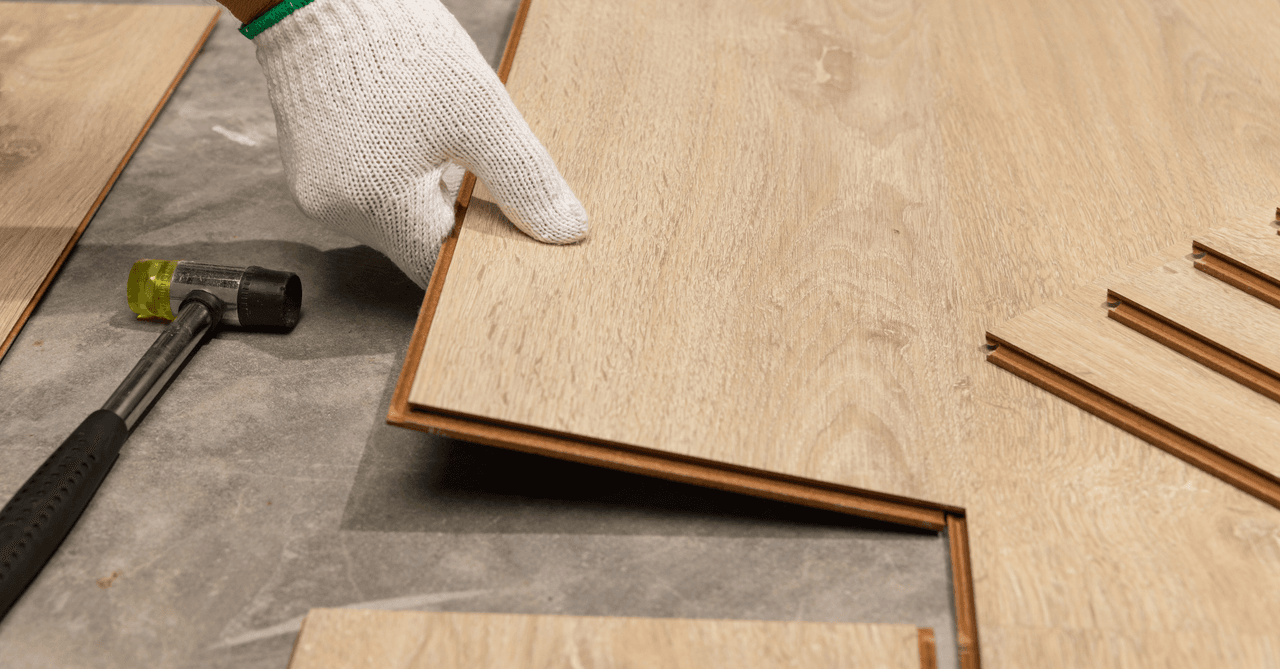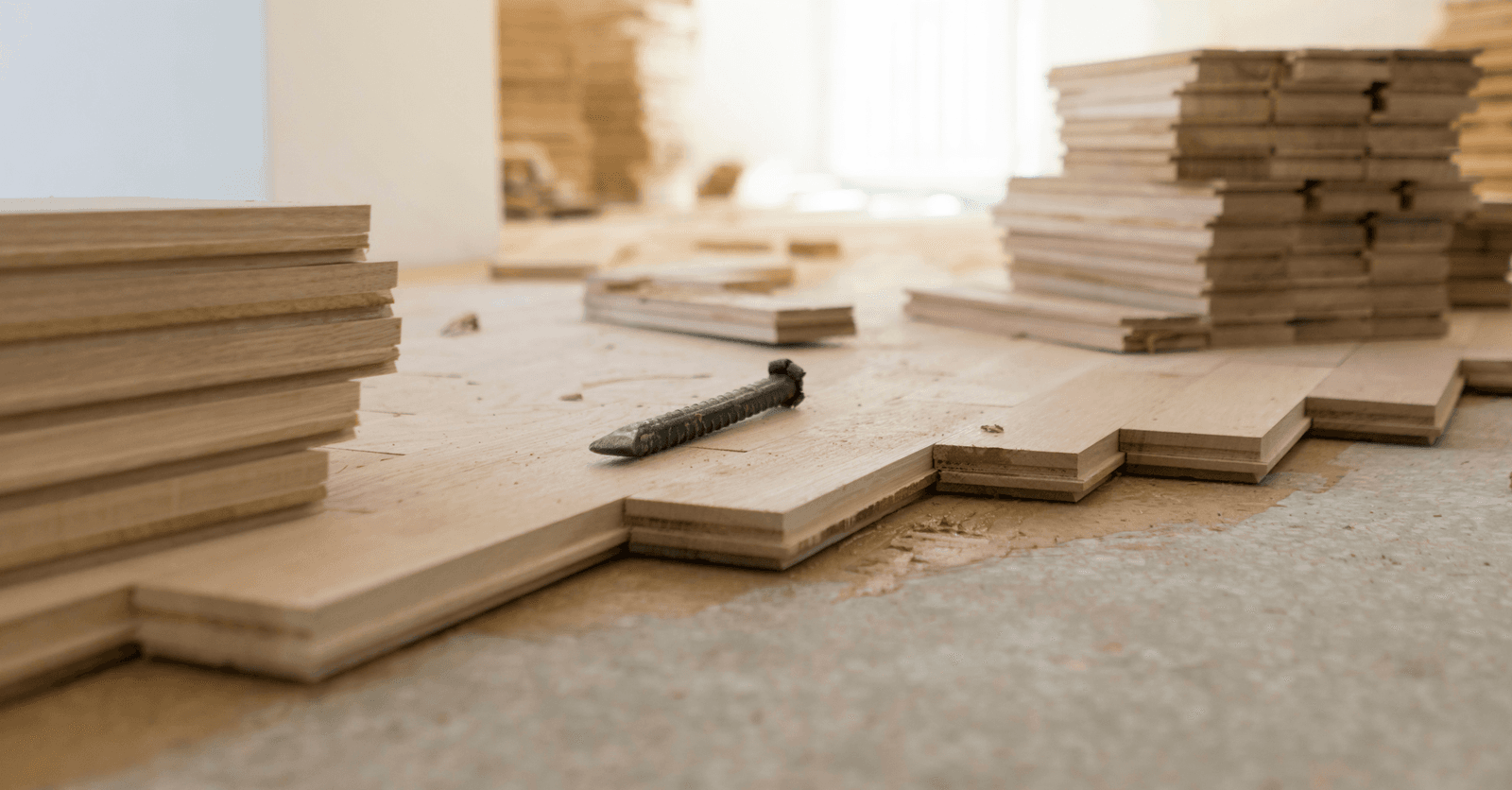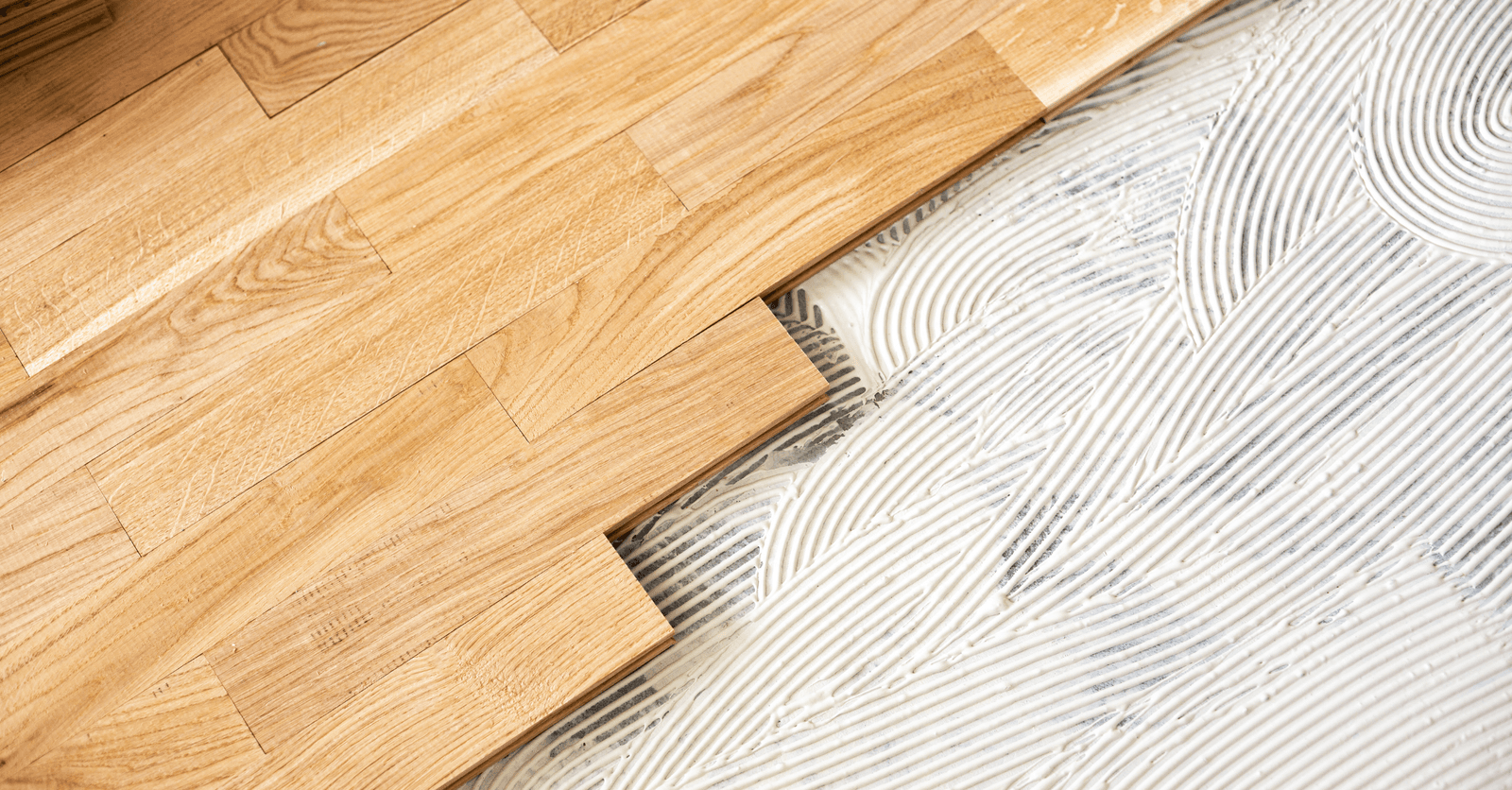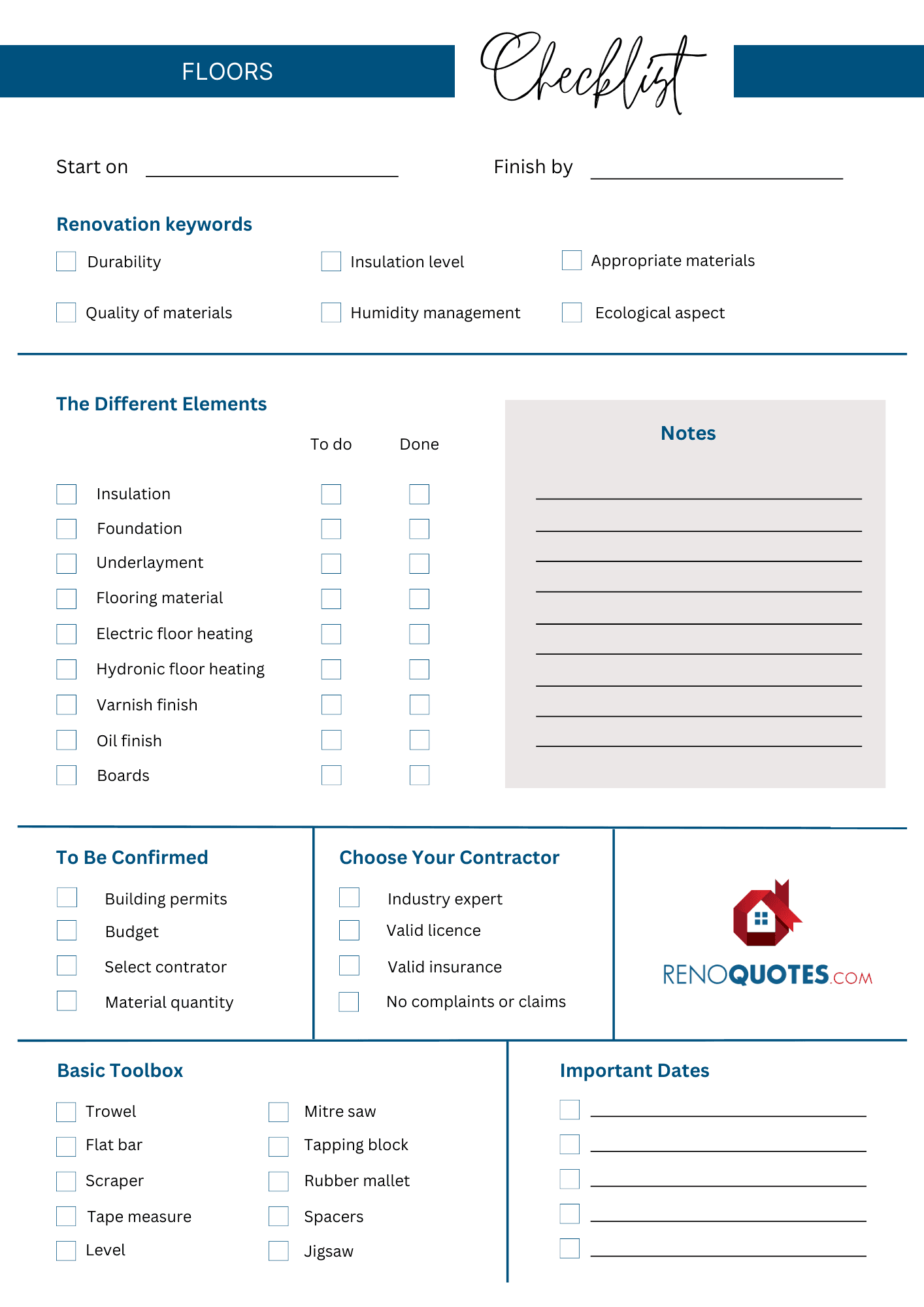Floor Renovation Reference Guide: What Are the Key Steps?
By Editorial Team
Updated on September 5, 2024

In most rooms, flooring is subject to a lot of wear and tear from constant foot traffic, shifting furniture, falling objects, etc., making it a key surface to consider when designing the floor plan of any room.
How can you go about selecting flooring that couples wear resistance with aesthetics? What practical aspects should be prioritized to extend your flooring’s lifespan?
Whether your project consists of restoring old flooring, installing new surfaces, adding underlayments, and so on, our reference guide will be your go-to tool, from start to finish, no matter if you’re working with a contractor or heading the DIY route.
Before Jumpstarting Your Project

Source: Canva
Before getting to work, it's important to ask yourself a few questions about your budget, the materials you plan on using, and the outcome you’re hoping for. In the next few paragraphs, we'll delve into concepts and questions that can help narrow down your choices.
Flooring Renovation Project Keywords
Wear Resistance
Unless you’re installing new flooring in a low-foot-traffic area, steer your decision-making toward a material that can withstand everyday wear without wearing itself to the core after a few months. The flooring in question must be wear-resistant; this factor will affect both material selection and installation methods.
Installation
Some flooring options are relatively easy to install and, therefore, you might be tempted by the DIY route to save a bit of money. However, if you go about it wrong or make mistakes along the way, the result is likely to be subpar and the floor’s durability may be jeopardized.
Suitable Materials
Is your project centred around laying new flooring in a bathroom? Make sure to select a type of flooring and underlayment that is suited to this specific setting. Otherwise, you might be faced with a few setbacks from the get-go.
Although we used a bathroom as a setting example, said tidbit of advice applies to most rooms in your home, including the kitchen, entryway, bedroom, and basement. Moreover, it depends on how you plan on using the rooms. We'll circle back to this below.
Questions to Ask Yourself When Planning a Floor Renovation Project
Does the current flooring need replacing or restoring?
The first question to ask yourself, one you may not have thought of is: Why not just restore the current floor? Naturally, doing so isn’t always a possibility, but people tend to cover their old flooring with their new one, instead of carrying out restoration work. For example, if you have very damaged hardwood flooring, maybe it can be revamped by a skilled contractor.
How much will new flooring cost?
One of the first things that can help narrow down your project aspirations is gauging the amount you’re willing to spend. This will better outline materials that are budget-friendly and the square footage you can restore. To plan your budget and figure out how much your project is likely to cost, skip ahead to our section titled “Flooring Renovation Project Budget Planning.”
What are my aesthetic preferences?
There are endless flooring shades, finishes, and textures, so much so that you may be overwhelmed by the sheer amount of choices. To streamline said process, we highly recommend that you do your research from the outset.
You can check out our flooring renovation ideas and create a Pinterest account where you can pin your favourite flooring ideas. Next, head to the nearest store to consult with experts and discuss your findings with your contractor.
How do I plan on using the space where the new flooring will be installed?
As mentioned already, the type of flooring you choose has to be well-suited for the intended space. In a kitchen, the material should be highly resistant and easy to clean. The flooring has to be waterproof and shock-resistant.
In a living room, you can be a bit more lenient, but you still have to consider how the room is used on a daily basis. For example, if you have kids, you may want to steer clear of slippery or high-maintenance flooring.
Should I hire a specialized flooring contractor?
Some projects are DIY-friendly and hassle-free. However, some are rather time-consuming, and in the end, it may be less cost-effective than hiring flooring experts.
For wear-resistant, professionally installed, and warranty-covered flooring, hiring specialized contractors is your best bet, tenfold.
Should I buy the flooring myself?
Have you fallen head over heels for discounted flooring? If you know how much square footage you need, it’s not a bad idea. On the other hand, if you consult your contractor beforehand, you’ll be able to limit the margin for error for, let’s say, subflooring, material quantities, finishing products, and the list goes on. Moreover, specialized contractors often have better pricing given that they buy material in bulk.
Will I have to relocate during the renovations?
If you’re planning on renovating a large portion of your flooring, you may have to relocate for a few days. Typically, the renovations don’t take that long and will likely depend on the scope of work.
For example, your subflooring may need reinforcing or your new flooring may need a finish that takes several days to cure before it’s fit for foot traffic. Check with your contractor to know how many days the work will take. This will help you decide whether you need to move out for a few days or not.
Working with a Flooring Renovation Contractor or Company
We already mentioned working with a flooring contractor, but note that these experts often specialize in type-specific flooring installation.
For example:
Hardwood flooring installation and refinishing
Ceramic or stone flooring installation and restoration
Underfloor heating system installation and repair
The list goes on. Many flooring contractors provide services for all flooring types, but you may benefit from signing on with professionals who have developed flooring-specific skills.
Flooring Renovation Project Budget Planning
The overall cost of such a project can differ significantly, depending on the flooring material, room measurements, installation complexity, and the contractor's rates.
As such, it's rather challenging to present exact numbers so you can plan your budget accordingly. However, we do have articles and tools detailing the average installation and material costs. With that information in mind, you can set aside a budget for your renovation project.
Check out these articles:
For a better idea of how much to budget, give our cost estimator a try:
Do I Need a Permit for a Flooring Renovation Project?
In the vast majority of cases, interior flooring renovations don't require permits. However, don’t take anything for granted and check your municipality's website or contact municipal authorities to verify whether the above-mentioned claim applies to your situation.
To learn more about renovation work requiring building permits, check out this article:
Hardwood, Concrete, Ceramic, Vinyl Flooring, And More

Source: Canva
Here’s a list of the main flooring materials retailed and most sought-after in Canada:
Material | Characteristics |
Bamboo | Sustainable, eco-friendly, low-maintenance |
Hardwood floors | Versatile yet costly and high-maintenance |
Ceramic | Affordable, great option for humidity-prone areas |
Laminate | Cost-effective and easy to install |
Concrete | Versatile, customizable, requires a professional installation |
Vinyl and linoleum | Soft texture with soundproofing properties |
Natural Stone | Sustainable, waterproof, and, above all, aesthetic |
Carpeting | Comfortable, cozy, high-maintenance |
This goes without saying, but there are other types of flooring, but we don’t yet have in-depth articles detailing everything there is to know about them. However, we do have a couple of articles that provide a quick overview of other flooring types:
Best Room-Based Flooring Options
We also have several articles that explore the top flooring options for specific rooms:
Insulation and Soundproofing: Different Types of Subflooring
When undertaking a flooring renovation, rare is it that your first thought is directed at what’s sitting beneath the flooring. However, use this as your cautionary tale to not overlook your subflooring! Subflooring has a myriad of purposes:
Insulation
Soundproofing
Resistance
Durability of structure
If you hire a contractor, they will point you toward the best subflooring for your current situation. However, it’s still worth knowing the different materials out there and possible installations.
To learn more, check out this article:
What Is There to Know About Underfloor Heating?

Source: Canva
At last, let’s delve into underfloor heating! This type of system works with liquid-channelling tubes (heat transfer or hydronic) or infrared technology (electric system).
To learn more about the different options marketed and the upsides and drawbacks of each system, check out these articles:
Floor Maintenance and Care Tips
Once your new flooring is installed, start thinking about regular and semi-regular upkeep to keep your flooring looking new. Here are articles that address floor-specific maintenance:
Repairs and Finishes (Varnish)
We can’t, under good conscience, broach the topic of floor-related renovations, without mentioning floor finishes.
Along with floor finishes, sanding and repairing aren’t far behind. Indeed, to restore flooring to its former glory or apply a long-lasting finish, it’s important to use the right products and methods.
Here are articles about floor varnish:
Lastly, we also have a few articles that detail some useful tips for floor refinishing purposes:
Flooring Issues
Unfortunately, floors are exposed to so much that problems of all sorts aren’t unlikely, including issues that aren’t necessarily related to the flooring itself.
Here are common examples of flooring problems:
How to Remove Flooring
Looking to remove old flooring before laying a new one? Doing so can be more of a tricky undertaking than one might think.
Flooring Renovation Project Steps
Flooring renovation steps will differ based on the type of work you plan on executing. Naturally, flooring restoration guidelines won’t be the same as those for laying new flooring, from start to finish.
However, we can still highlight a few crucial steps to ensure everything goes smoothly.
Steps:
Determine what kind of flooring renovation project you want to carry out.
Contact contractors for project quotes (if applicable).
Choose materials and products.
Prepare the area (remove furniture, protect select surfaces, prepare products and materials).
Start working (repairing, installing, etc.).
If needed, allow for a delay period before treading on your new floors to ensure the floor finish applied is fully cured or the flooring has settled in its new environment.
Wrap up the project.
How a Flooring Project May Impact Your Everyday Life
If your project is confined to a single area/room, you’ll most likely be able to stay put for the duration of the work. However, if you plan on repairing and/or changing your flooring in several rooms, you may need to relocate for a few days or avoid said areas, if possible, for the duration of the project.
To make sure your project unfolds under the smoothest of conditions, check out these two articles:
Flooring Renovation Project Toolkit
If you’re looking to carry out some DIY flooring restorations or installation, get your hands on the following tools:
Trowel
Pull bar
Scraper
Level
Measuring tape
Miter saw
Tapping block
Rubber mallet
Wedge spacers
Jigsaw
Pneumatic stapler
Air compressor
Drill and bits
Sponges
Pliers
Flooring Renovation Project Checklist

Looking for something else?
Related articles
The latest industry news, interviews, technologies, and resources.

Editorial Team
•07 Nov 2023
Who wouldn't like to add a hint of wood to their decor or integrate it as part of a construction project? Wood suits almost every aesthetic, it's available in countless different finishes, can be used for just about anything, is derived from a renewable source, and is perfect to scaffold zero-carbon buildings.

Editorial Team
•03 Nov 2025
Are you planning to renovate your exterior siding soon? To help you prepare for this project, we have created this checklist/guide where you can learn more about the different materials, the stages of the work and the questions to ask yourself before launching the project.

Editorial Team
•16 Dec 2024
Whether it’s your house, condo, or apartment, the need or desire to spruce up the decor after a while is completely expected. But, who should you hire for this sort of project, an interior decorator, an interior designer, or maybe even an interior architect? While these professions might appear similar, they involve distinct skills and roles, each tailored to specific needs.

Editorial Team
•24 Jan 2025
In many Canadian regions, fireplaces become the heart of the home for 3 out of the 4 seasons. The wood crackling in the hearth, the comforting smell of burning wood, and the cozy ambience of the room—whether we consciously acknowledge it or not—all contribute to a fireplace's undeniable charm.

Editorial Team
•23 Feb 2024
Every year, between 3 and 5 million tons of asphalt concrete is poured over Quebec’s roadways. While conventional asphalt is still most commonly employed, other materials are making their way onto the scene, filling in cracks, such as recycled asphalt.